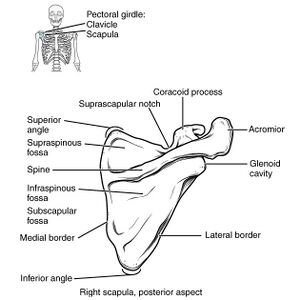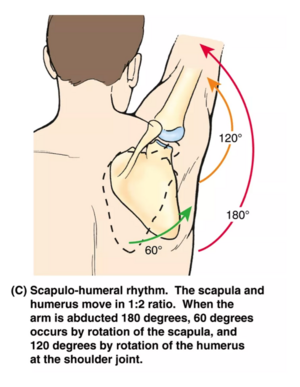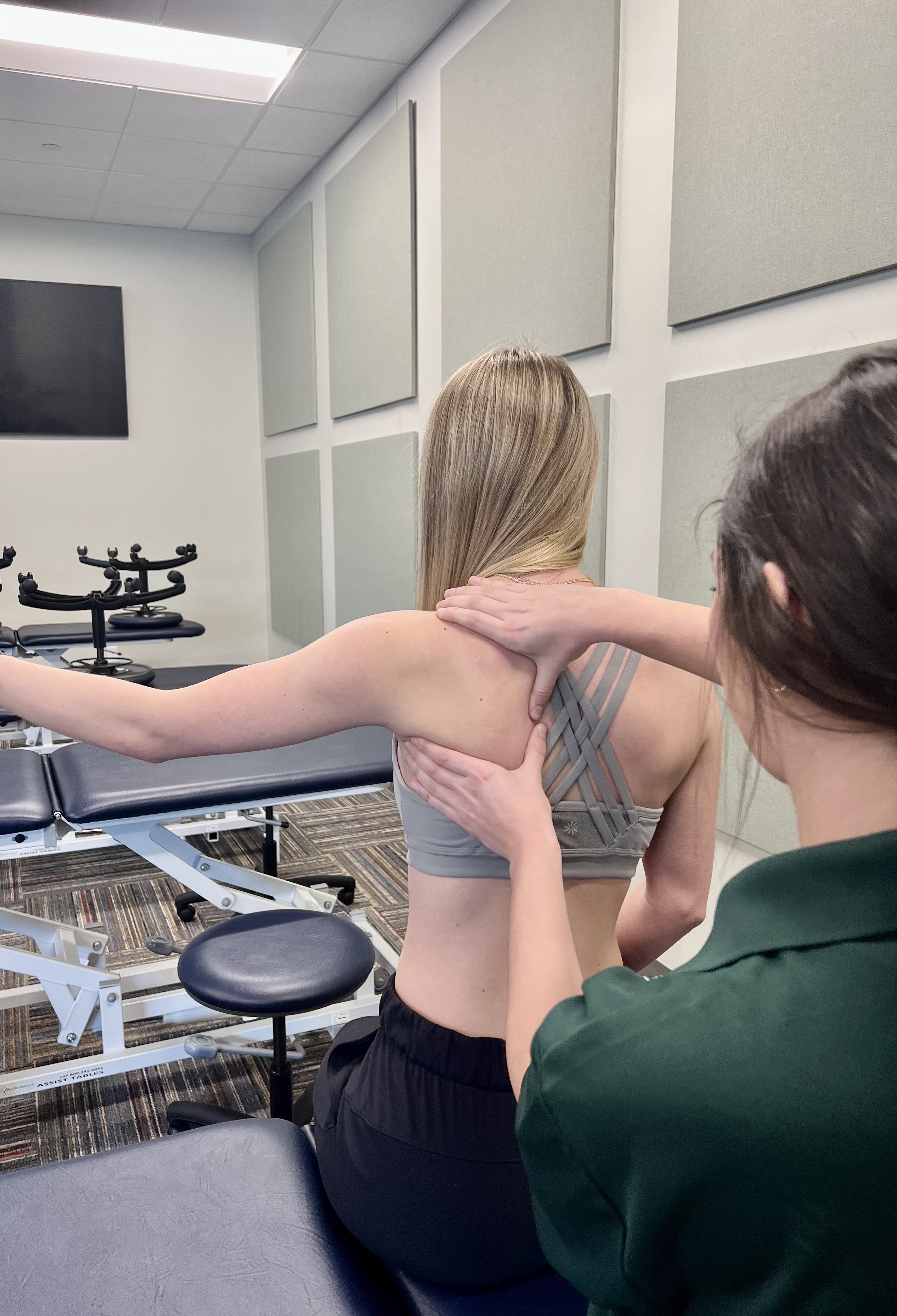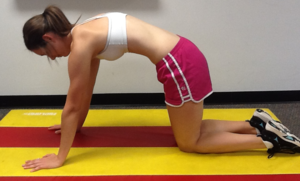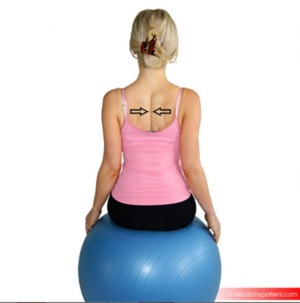Snapping Scapula Syndrome
{{subst:Arkansas Colleges of Health Education School of Physical Therapy Musculoskeletal 1 Project}}
This article or area is currently under construction and may only be partially complete. Please come back soon to see the finished work! (3/04/2023)
Definition/Description:[1] Snapping scapula syndrome is defined as an audible or palpable clicking, grinding, or crepitus noise of the scapula during movements involving the scapulothoracic joint. It is more of a symptom of other diagnoses. It is commonly seen in younger active individuals. These individuals often have a history of pain, discomfort, and weakness with overhead movements which can result from sporting activities or overuse. The symptoms of snapping scapula syndrome can be insidious, be due to a result of trauma or from excessive grinding of the scapula and the thorax with soft tissues entrapped between them, such as bursas, muscles, or tendons.[2] Pain is typically not reproducible with isometric movements. The clicking and popping, as well as pain usually decreases when crossing the arm across the chest, this causes the scapula to lift from the rib cage. This syndrome is oftentimes overlooked due to a lack of awareness about the diagnosis.
Anatomy:[3] The scapula is a triangular-shaped bone that originates between the second and seventh ribs. It consists of 3 borders, superior, medial, and lateral, as well as 2 angles, superior and inferior.[4] It articulates with the posterior chest wall and is alone in conjunction with the upper limb by the acromioclavicular joint. The acromioclavicular joint has no distinct movements and is only associated with movements by the scapulothoracic joint. The scapulothoracic joint movement is dependent on the acromioclavicular and sternoclavicular joints. The scapulohumeral rhythm is a combination of motions of the scapula, clavicle, and humerus to get full elevation of the arm, which has a 2:1 ratio. This means for every two degrees of movement at the humerus, the scapula moves one degree. To get the full 180 degrees of elevation of the arm, 120 degrees of movement occurs at the glenohumeral joint, while 60 degrees of upward rotation occurs at the scapulothoracic joint. The scapula must upwardly rotate, posteriorly tilt and externally rotate, while the clavicle must elevate, retract and posteriorly roll. The thoracic spine must extend. The muscle synergists for upward rotation are the upper and lower trapezius and the serratus anterior. The scapula's stability is dependent on the surrounding musculature, with several muscles that attach directly to the scapula. The levator scapulae attaches at the superior angle of the scapula, while the teres major attaches at the inferior angle of the scapula. The rhomboids major and minor attach to the medial border of the scapula, whereas the serratus anterior attaches to the medial margin. The subscapularis originates on the anterior surface of the scapula, also known as the subscapular fossa. The infraspinatus attaches to the posterior surface, also known as the infraspinous fossa. The superior portion of the posterior side is also known as the supraspinous fossa and the supraspinatus attaches here. The 4 rotator cuff muscles include the supraspinatus, infraspinatus, subscapularis, and teres minor. These 4 muscles form a musculotendinous cuff around the glenohumeral joint and provide muscular support to the joint.[1]
Causes: Snapping scapula syndrome can have a variety of different causes. Typically, it is a result of overuse of the arm, such as repetitive overhead activities, however, it can also be due to trauma to the shoulder blade region. Aside from these variations, snapping scapula can be caused by anatomical variations and certain diseases. Some anatomical variations can include excessive forward curvature of the superomedial border of the scapula, whereas some diseases can include osteochondromas or scapular dyskinesis, also known as SICK scapula.
Scapular dyskinesis is defined as abnormal movements of the shoulder blade and there are a variety of causes for this, however, most are attributed to errors and are mostly dysfunctional rhythm and timing of the associated shoulder musculature. There is primary, secondary, and dynamic scapular winging. Primary scapular winging is mainly due to muscle weakness of one of the scapula stabilizers. Secondary scapular winging is when the normal movement of the scapula is altered due to glenohumeral joint pathology. Dynamic scapular winging can be due to a lesion of the long thoracic nerve which affects the serratus anterior, causes trapezius palsy, rhomboid weakness, multidirectional instability, voluntary action, and pain in the shoulder which can cause reverse scapulohumeral rhythm.
Changes in alignment to the structures, such as a fractured scapula or rib that doesn't heal or line up correctly can cause the sounds and sensations of this syndrome. Abnormal bumps and curves on the scapula’s medial border can cause bursas to form, thus leading to inflammation causing bursitis to occur. Scapulothoracic bursitis is a common cause, which is inflammation of the bursa under the shoulder blade.[5] It can occur from trauma to area, from a cause of repetitive movements of the joint, or be due to scapular dyskinesis. Another cause is from inactivity of the musculature under the scapula, causing the scapula and rib cage to grind against one another during movements.[3]
Clinical Presentation/Characteristics:[1][6]
- Popping, clicking, grinding with overhead movements
- Pain with overhead movements
- Pain can be dull, achy or sharp
- Lack of coordinated movements of shoulder
- Weakness
- Winging of the scapula
- Abnormal scapular movements
Examination: Some common questions a physical therapist may ask a patient during the evaluation process if they suspect they may have snapping scapula syndrome:
- How and when did you first notice the pain?
- With what activities do you hear or feel popping, clicking and grinding symptoms?
- Do you have any pain or stiffness in your neck?
- Does your shoulder feel weak or “tired?”[6]
Evaluation Process:[7]
- Pain & Functional Questionnaires/ Health Assessment:
Pain with overhead activities? Repetitious occupation? MOI? Trauma? Overuse?
- Initial Observations of the Patient:
Bilateral asymmetry of the scapulas? Scapular winging? Poor posture? Popping, clicking, crepitus with movements?
- Structural Inspection:
C-spine or thoracic deformities? Bony abnormalities?
- Palpation for Condition:
Obvious bony deviations? Soft tissue atrophy? Palpable crepitus?
- Range of Motion:
Active range of motion (AROM) quality and quantity, coordination, symptoms reproduced? Compensations? End feel?
Passive range of motion (PROM) quality and quantity, coordination, symptoms reproduced? Compensations? End feel?
Joint Accessory motion, joint integrity? Quantity? End feel? Dysfunction?
- Resisted Isometric Contraction:
Painful and weak? Painful and strong? Painless and weak? Painless and strong?
- Muscle Length Testing:
Tight Pectoralis, Trapezius, Levator Scapulae, Latissimus Dorsi, Subscapularis, Sternocleidomastoid, Rectus Capitis or Scalenes?
- Muscle Strength:
Weakness in upper, middle, and lower Trapezius, Rhomboids, Serratus Anterior, Latissimus Dorsi, Levator Scapulae, Rotator cuff muscles or Deltoids?
- Special Tests:
Special testing to help rule in or out if the patient has snapping scapula or other shoulder pathologies.
- Scapular Assistance Test
- Lateral Scapular Slide Test
- Movement/Functional Analysis:
Assessment of scapulohumeral rhythm and functional overhead activities
- Palpation for Tenderness:
Tenderness at the superior angle or medial border of the scapula?
- Neurovascular:
Long thoracic nerve involvement?
- Diagnostic Imaging:
X-rays and MRIs can both be used in helping diagnose snapping scapula syndrome.
X-rays can show the scapular angles, skeletal or rib abnormalities, as well as any other bony deformities that may be causing these symptoms.
MRIs give the best look at soft tissues.[8]
Special Tests: There are no special tests for snapping scapula syndrome specifically, but there are special tests to rule out other scapula pathologies.
Scapular Assistance Test:
- The patient will perform forward shoulder flexion
- For the involved shoulder, the physical therapist will assist the patient during forward shoulder flexion by promoting normal scapular mechanics by stabilizing the upper scapular border and assisting with upward rotation of the inferomedial border
- The physical therapist will compare the unassisted movement to the assisted movement
- If the patient feels better with assistance, this is a positive (+) test
Lateral Scapular Slide Test:
- The patient is asked to abduct the involved arm to 0, 45 (with internal rotation), then 90 (with maximal internal rotation) degrees
- The physical therapist measures the distance from the inferior angle of the scapula to the thoracic spinous process at the same level
- The physical therapist repeats step one and two on the uninvolved side to compare
- A positive (+) test is indicated when a side-to-side difference of 1-1.5 cm is detected
Outcome Measures:
- DASH or QuickDASH: Disabilities of the Arm, Shoulder, and Hand
DASH is a self-reported questionnaire that consists of 30 questions asking about the difficulty level and obstruction in everyday life. QuickDash is a condensed version of DASH and consists of 11 questions.
- PSFS: Patient Specific Functional Scale
PSFS is self-reported and allows the individual to choose at 3-5 activities that are difficult. The activities chosen are then rated on their ability to be performed. The rating is done on a 0 -10 scale with 0 being unable to perform and 10 being able to perform at pre-injury level.
- UEFS: Upper Extremity Functional Scale
UESF scale is made for individuals with a dysfunction of the shoulder, elbow, wrist, or hand. It is self-reported and asks about 20 daily activities that are rated on a 5 point scale. The 5 point scale ranges from 0-4 with 0 being extremely difficult and 4 being not difficult.
- SPADI: Shoulder Pain and Disability Index
SPADI consists of 13 questions that are self-reported regarding the pain and disability level of daily activities. There are 5 pain questions and 8 disability questions. SPADI is scored on a 0 to 10 numerical scale.
Conservative Management: Typically when scapulothoracic popping and clicking is related to a soft tissue abnormality, poor posture or scapular dyskinesis surgical intervention will not be needed.
- Non-steroidal anti-inflammatory medications (NSAIDs)
- Cortisone injection into the space underneath the scapula where the inflammation occurs; typically repeated 3-4 times a year[9]
- Physical therapy
Preventative Measures:[6]
- Maintain upright posture, avoiding slumping
- Maintain scapular strength and muscles surrounding the shoulder joint
- Use appropriate techniques when performing overhead arm movements
- Maintain flexibility of the musculature of the neck, shoulder and scapula
If conservative management fails to alleviate symptoms after 3 to 6 months, surgical interventions need to be considered.
Physical Therapy Management:[6]
- Ice/Heat packs
- Ultrasound
- Diathermy
- Electrical Stimulation
- Laser Treatment
- Soft Tissue Massage of the Scapula
- Trigger Point Releases of the Chest, Neck and Shoulder
- Strengthening exercises of the Serratus Anterior, Mid and Lower Trapezius, Rhomboids and Rotator cuff muscles
- Stretching of the Pectoralis Major and Minor, Levator Scapulae, Upper Trapezius, Latissimus Dorsi, Subscapularis, Sternocleidomastoid, Rectus Capitis, and Scalene muscles
- Address postural issues to make sure the patients head, neck, and shoulders are lined up according to the the kinetic chain model
- Kinesio-taping of the Scapula
- Passive motions of the arm, neck, shoulder and scapula
- Scapular mobilizations
Common Exercises for SSS:
- Cat-Cow
- Shoulder Rolls (forward & backward)
- Prone “Y” exercise for the Lower Trapezius
- External and Internal Rotation with therabands/weights
- Serratus Anterior Punches
- Scapular Retractions
- Gradual incorporation of functional movements and/or activities that relate directly to the patient and their goals
Surgical Intervention:
- Arthroscopic Scapulothoracic bursectomy: removal of the inflamed tissue from the scapula thoracic space
- Scapular dissection: a bony portion of the scapula that is prominent may be removed due to friction against the ribs
- A scapulothoracic bursectomy is when part of the medial angle underneath of the scapula is shaved off and the inflamed bursa between the ribs and scapula is removed. This surgery is outpatient so the patient can return home the same day. Recovery time is usually four to six months. During the first four weeks the patient will be required to wear a sling to limit movement and physical therapy will be started within the fifth-week post-operation.[9]
Rehabilitation Post Scapulothoracic Bursectomy per Dr. Anthony Romeo, Orthopaedic Surgeon:[9]
Weeks 1-4:
- Wear a sling for 4 weeks
- Can do pendulums
- Advocate for shoulder ROM
Weeks 4-6
- AAROM with isometrics for the shoulder
- ADLs without the sling
- Wear a sling in public for 6 weeks
Weeks 6-3 months
- Continue AROM
- Theraband exercises for scapular rotators
- Expect to return to work
References:
- ↑ 1.0 1.1 1.2 Merolla, G., Cerciello, S., Paladini, P., & Porcellini, G. Snapping scapula syndrome: current concepts review in conservative and surgical treatment. Muscles, ligaments and tendons journal, (2013). 3(2), 80–90.
- ↑ Baldawi, H., Gouveia, K., Gohal, C., Almana, L., Paul, R., Alolabi, B., Moro, J., & Khan, M. Diagnosis and Treatment of Snapping Scapula Syndrome: A Scoping Review. Sports health. 2022;4:389–396.
- ↑ 3.0 3.1 de Carvalho, S. C., Castro, A. D. A. E., Rodrigues, J. C., Cerqueira, W. S., Santos, D. D. C. B., & Rosemberg, L. A. Snapping scapula syndrome: pictorial essay. Radiologia brasileira, (2019). 52(4), 262–267.
- ↑ The Skeletal System. Available from: https://www.theskeletalsystem.net/arm-bones/scapula.html. (accessed 18 March 2023).
- ↑ Kiritsis, P. A patient’s guide to snapping scapula syndrome. Available from: https://www.kneeandshouldersurgery.com/shoulder-disorders/snapping-scapula-syndrome/#:~:text=Scapulothoracic%20bursitis%20refers%20to%20inflammation,sensations%20 of%20 snapping%20 scapula%20syndrome. (accessed 22 March 2023).
- ↑ 6.0 6.1 6.2 6.3 Avruskin, A., Physical therapy guide to snapping scapula syndrome. Available from: https://www.choosept.com/guide/physical-therapy-guide-snapping-scapula-syndrome (accessed 14 March 2023).
- ↑ Manske, R.C., Reiman, M.P. Nonoperative and operative management of snapping scapula. The American Journal of Sports Medicine. 2004;32:1554-1565.
- ↑ Lazar, M.A. Diagnosis and treatment of snapping scapula syndrome. Evidence Sport and Spine. 2009;91:2251-2262.
- ↑ 9.0 9.1 9.2 Rome0, A. Snapping scapula. Available from: https://www.anthonyromeomd.com/services/snapping-scapula/ (accessed 24 March 2023).
- ↑ Keri Henderson. Scapular Lift Mobilization. Available from: https://www.youtube.com/watch?v=cyup03gGYdE [last accessed 30/3/2023].
- ↑ Keri Henderson. Serratus Anterior Punch Exercise. Available from: https://www.youtube.com/watch?v=6WQ8cK6CTyE [last accessed 30/3/2023].
